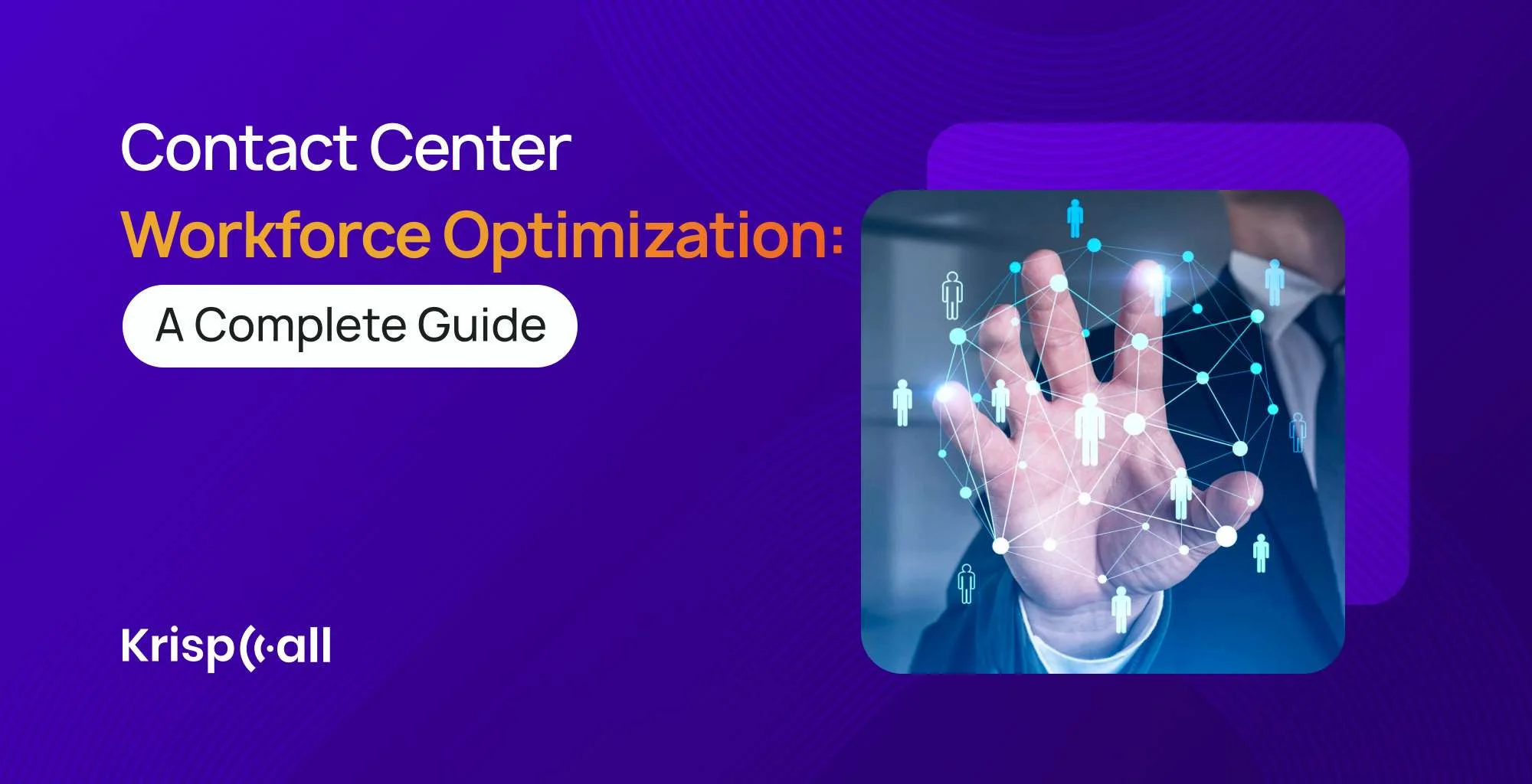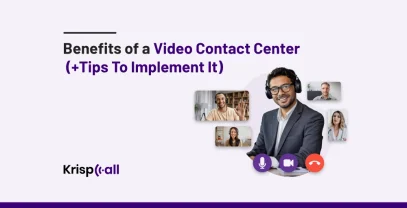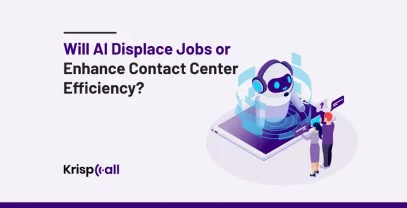Are you struggling to keep your contact center working smoothly?
You are not alone. Many firms face similar issues every day.
Fortunately, contact center workforce optimization provides a solution. By addressing the root causes of inefficient operations and customer discontent, workforce optimization connects your team’s efforts with your company objectives, resulting in smoother operations and happier customers.
What is contact center workforce optimization?
Contact center workforce optimization is the process of maximizing the efficiency and effectiveness of the workforce in a contact center environment.
Here the term “workforce” describes the group of people employed by a certain company or sector. Contact center workforce optimization involves implementing strategies, tools, and techniques to enhance staffing levels, scheduling procedures, training programs, performance management systems, and operational processes.
Contact Center workforce optimization (WFO) ensures that call center employees perform with as little hassle. Its objective is to improve customer service, increase productivity, and maintain the smooth functioning of the business by optimizing staffing, scheduling, training, and performance through different strategies and techniques.
Benefits of workforce optimization in contact center
Contact centers benefit greatly from workforce optimization, which simplifies operations and improves job performance for everyone. Some of the benefits of workforce optimization in contact center are :
- Improved Operational Efficiency: Contact center operations can be simplified using workforce optimization, which promotes more efficient workflows and resource use. With fewer waiting times and higher overall service quality, contact centers are better optimized to manage consumer inquiries.
- Enhanced Customer Experience: By implementing optimal staff management, contact centers may ensure customers receive prompt and personalized help, increasing customer satisfaction and loyalty. The availability of agents with the necessary abilities to handle inquiries leads to more effortless interactions and a better overall experience for clients.
- Increased Employee Engagement and Satisfaction: A positive work environment is promoted via workforce optimization, which gives staff members better planning, opportunities for training, and support. Employee engagement, job happiness, and morale all rise as a result, which lowers reduction and raises performance standards.
- Cost Savings: Cost savings is one of the benefits of workforce optimization in contact centers. Optimizing and task assignments reduce idle time and overtime expenditures. This efficiency leads to greater resource usage while avoiding wasteful expenses.
- Better Decision Making: Contact centers may use workforce optimization to not only simplify their operations but also make better decisions that generate long-term growth and an edge in the ever-changing customer service industry.
What is WFO’s role in a contact center?
In a call center, the main role of Workforce Optimization (WFO) is to help administrators identify the right employee numbers for various times, and balance busy hours with slower periods to reduce customer wait times. Furthermore, WFO also has an important role in helping workers to improve their performance by providing feedback and guidance.
Contact center workforce optimization includes the use of Call center workforce optimization tools and techniques whose primary goal is to optimize and enhance different aspects of contact center operations. Such operations include agent performance, scheduling, training, quality management, and resource usage. This complete approach seeks to maximize labor productivity, improve customer happiness, and ultimately drive superior business outcomes for the contact center.
WFO acts as a dedicated supervisor while recognizing and dealing with any concerns and assuring compliance with rules and regulations. Ultimately, WFO’s main objective is to ensure that customers receive quick help and that everyone in the contact center is performing to the best of what they can do.
How does Contact center workforce optimization work?
Contact center workforce optimization works by organizing and managing the staff who work in a customer service center. First, managers utilize data to estimate how many customers may require support in the future.
Then they construct schedules to ensure there are enough staff available when a large number of clients are expected. Leaders additionally track how successfully employees execute their duties, ensuring that they adhere to their timetables and provide excellent customer service. If something isn’t going well, supervisors can adjust schedules or offer additional assistance.
They can also help employees improve their skills if necessary. Overall, workforce optimization guarantees that the customer service center is structured, efficient, and prepared to serve consumers whenever they need it
Workforce Management is operated to create an equilibrium between workforce and workload. It includes Quality management, Performance management, and Workforce management :
- Quality management (QM): Quality management (QM) is an important operational component of contact center optimization. It assures that customer interactions meet excellence standards. It helps to improve the overall efficacy and success of workforce optimization activities. QM improves service quality, agent performance, and customer happiness, all of which are critical goals of contact center labor optimization.
- Performance management: Performance management is a key component of contact center staff optimization. It functions in monitoring agent performance and evaluation against key performance indicators (KPIs) such as average handling time, customer satisfaction, and schedule adherence. Furthermore, it helps to improve agent productivity, efficiency, and overall performance by offering feedback, coaching, and training opportunities.
- Workforce management: Workforce management is an additional vital part of contact center workforce optimization. It includes activities such as scheduling and forecasting resource allocation to ensure that there are enough agents with the necessary abilities to handle consumer inquiries effectively and efficiently. As a result, it is a critical component of contact center labor optimization efforts aimed at increasing operational efficiency and customer satisfaction.
10 Best strategies for effective contact center workforce optimization
Contact centers can ensure they have the right number of workers with the necessary abilities to assist customers successfully. Here are some of the best strategies for effective call center staff optimization.
1. Forecasting and Scheduling
Forecasting entails estimating future phone numbers, chat engagements, email inquiries, and any other forms of consumer interactions that a contact center may encounter. Accurate forecasting is critical for efficient resource planning.
Scheduling means assigning operators to certain shifts and activities based on expected demand and agent availability. The goal is to have enough agents with the relevant abilities on hand at all times to address customer requests while keeping operational expenses and employee preferences in check.
Key aspects of scheduling include:
- Shift Planning: Determining the number of agents needed for each hour or interval of the day based on forecasted contact volumes.
- Skill-Based Routing: Assigning agents with specific skills to handle particular types of contacts to ensure efficient resolution.
- Adherence to Labor Laws: Ensuring compliance with labor laws regarding working hours, breaks, and overtime to avoid legal issues and maintain employee well-being.
- Flexibility: Building mechanisms for flexibility to accommodate unexpected fluctuations in contact volume or agent availability.
- Agent Preferences: Taking into account agent preferences for shifts, days off, and work-life balance to improve job satisfaction and retention.
2. Real-time adherence Monitoring
It is also one of the essential components of successful contact center labor efficiency techniques. It entails monitoring agents’ activity in real-time to ensure that they complete their assigned duties and commitments. This monitoring technique enables contact center managers to quickly identify and address deviations from the timetable, resulting in increased productivity and operational efficiency.
3. Quality Assurance and Monitoring
Quality assurance (QA) and monitoring are key methods for improving contact center employees’ performance. QA entails assessing interactions to ensure they fulfill predetermined quality standards. This includes monitoring agent behavior, following instructions, providing accurate information, and ensuring customer satisfaction.
4. Training and Development Programs
These programs include extensive training in communication strategies, product understanding, issue-solving, and effective use of technological systems. They strive to improve agents’ ability to handle consumer concerns efficiently and provide appropriate resolutions.
Overall, quality training and development programs are critical in ensuring that contact center personnel have the necessary skills to provide good customer support.
5. Multichannel Integration
Contact centers that integrate multiple channels optimize operations, improve customer service, and increase overall efficiency. Agents may easily transition between channels without losing context, resulting in faster response times and more customer satisfaction.
6. Performance Metrics Tracking
Performance metrics Tracking in contact center workforce optimization is the practice of evaluating and monitoring various aspects of staff performance to ensure customer service operations are efficient and productive. This includes monitoring key indicators such as:
- Call Volume
- Average Handling Time (AHT)
- First Call Resolution (FCR)
- Service Level
- Abandonment Rate
- Customer Satisfaction (CSAT)
- Agent Adherence
7. Technology Integration
Technology Integration in Contact Centers Workforce Optimization refers to the automatic incorporation of various technological tools and systems into contact center operations to improve efficiency and effectiveness. This includes using software and hardware solutions to automate jobs, streamline processes, and increase overall workforce performance.
For example, Salesforce CRM integration optimizes contact center operations, offering personalized service, efficient call handling, automated workflows, performance tracking, and a unified customer experience.
8. Flexible Work Arrangements
Flexible work arrangements refer to employees’ ability to modify their work schedules and locations to better meet their own and the contact center’s needs.
This could include alternatives such as flexible hours, which allow employees to begin and end work at different times, or remote work opportunities, which allow employees to work from home or other locations other than the usual office environment.
9. Employee Engagement Initiatives
Employee engagement initiatives in contact center workforce optimization are tactics that aim to increase employee motivation, satisfaction, and commitment.
These activities are aimed at creating a positive work atmosphere in which people feel respected, encouraged, and inspired to accomplish their best. Examples of employee engagement initiatives are:
10. Continuous Improvement Culture
This entails continually reviewing current procedures, identifying opportunities for improvement, and implementing changes to improve outcomes. Essentially, it is about instilling a culture of continuous learning and development among the contact center personnel.
The Future of Contact Center Workforce Optimization
The future of making contact centers better will involve using smarter technology and managing different ways people get in touch, and use information. Which helps to make decisions, organize people who work from home, make each interaction personal, and keep employees happy.
Advanced Analytics and AI
Advanced analytics and AI are fundamental to the future of contact center workforce optimization because they allow contact centers to optimize their personnel and improve efficiency in a variety of ways.
Predictive Modeling and Forecasting
Predictive estimation and forecasting in contact center workforce optimization entails using advanced algorithms and data analysis approaches to predict future client demand and manpower requirements.
Automation and Robotics
Automation and robotics in the future of contact center workforce optimization involve the use of machines and computer programs to do functions that were previously performed by humans. This improves the contact center’s efficiency and effectiveness in providing customer service.
Omni-channel Optimization
Omni-channel optimization is the future of contact center workforce optimization, focusing on enhancing communication across several channels for greater customer service and efficiency.
Remote and Flexible Workforce Management
Managing a remote and flexible workforce requires overseeing employees who work from multiple places and adapting schedules to meet the changing needs of the organization.
Optimize your Contact Center Workforce with KrispCall
KrispCall brings a range of features that greatly enhance contact center workforce optimization. It improves agent efficiency by swiftly directing calls to the most suitable agent through features like Automatic Call Distribution (ACD).
KrispCall equips contact centers with the tools necessary to optimize their workforce and improve efficiency to deliver superior customer service. Moreover, its integration with CRM systems facilitates quick access to customer information and boost productivity.
The platform enhances the overall customer experience by offering multiple features like
- Interactive Voice Response (IVR): allows call recording and monitoring for supervisors to identify communication areas for enhancement.
- Automatic Call Distribution (ACD): Automatically route incoming calls to the right agents and provide exceptional customer support from the get-go
- Bulk SMS: allows businesses to send mass text messages to customers for promotions, appointment reminders, or other updates.
- CRMs: Centralizes customer data and facilitates communication across different departments, like sales, marketing, and customer service.
FAQs
What is contact center workforce management?
Contact center workforce management is the process of maximizing agent staffing, scheduling, and performance to provide efficient and effective customer support operations.
What is workforce optimization?
Workforce optimization is the practice of increasing the efficiency and effectiveness of an organization’s workforce across all operations and divisions.
What is a contact center on the cloud?
A contact center in the cloud, also known as a cloud-based contact center is a customer support center that runs using cloud computing technologies.
What is call center optimization?
Call center optimization is the process of increasing the efficiency, efficacy, and overall performance of a call center. This includes a variety of methods and tactics aimed at increasing productivity, lowering expenses, improving customer happiness, and meeting company objectives.





